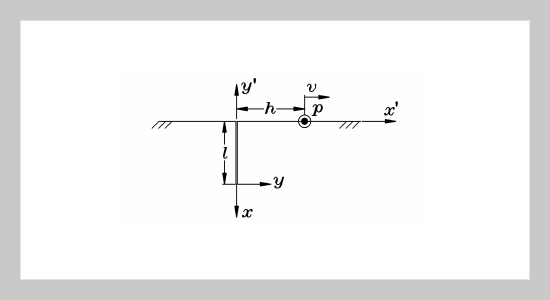REFERENCES
- [1] Achenbach, J. D., Wave Propagation in Elastic Solids, Elsevier, New York, U.S.A., (1973).
- [2] Brock, L. M., “Shear and Normal Impact Loading on One Face of a Narrow Slit,” International Journal of Solids and Structures, Vol. 18, pp. 467-477 (1982).
- [3] Brock, L. M., “Stresses in a Surface Obstacle Undercut due to Rapid Indentation,” Journal of Elasticity, Vol. 14, pp. 415-424 (1984).
- [4] Brock, L. M., Jolles, M. and Schroedl M., “Dynamic Impact Over a Subsurface Crack: Applications to the Dynamic Tear Test,” ASME Journal of Applied Mechanics, Vol. 52, pp. 287-290 (1985).
- [5] Chen, E. P. and Sih, G. C., “Scattering of Plane Waves by a Propagating Crack,” Journal of Applied Mechanics, Vol. 42, pp. 705-711 (1975).
- [6] Chen, E. P., “Impact Response of a Finite Crack in a Finite Strip under Anti-Plane Shear,” Engineering Fracture Mechanics, Vol. 9, pp. 719-724 (1977).
- [7] Chen, E. P., “Sudden Appearance of a Crack in a Stretched Finite Strip,” ASME Journal of Applied Mechanics, Vol. 45, pp. 277-280 (1978).
- [8] de Hoop, A. T., Representation Theorems for the Displacement in an Elastic Solid and Their Application to Elastodynamic Diffraction Theory, Doctoral Dissertation, Technische hoegschool, Delft (1958).
- [9] Flitman, L. M., “Waves Generated by Sudden Crack in a Continuous Elastic Medium,” Applied Mathematics and Mechanics (PMM), Vol. 27, pp. 938-953 (1963).
- [10] Freund, L. B., “The Stress Intensity Factor due to Normal Impact Loading of the Faces of a Crack,” International Journal of Engineering Science, Vol. 12, pp. 179-189 (1974).
- [11] Gakenheimer, D. C. and Miklowitz, J., “Transient Excitation of an Elastic-half Space by a Point Load Traveling on the Surface,” ASME Journal of Applied Mechanics, Vol. 36, pp. 505-515 (1969).
- [12] Ing, Y. S. and Ma, C. C., “Transient Response of a Finite Crack Subjected to Dynamic Anti-Plane Loading,” International Journal of Fracture, Vol. 82, pp. 345-362 (1996).
- [13] Ing, Y. S. and Ma, C. C., “Dynamic Fracture Analysis of a Finite Crack Subjected to an Incident Horizontally Polarized Shear Wave,” International Journal of Solids and Structures, Vol. 34, pp. 895-910 (1997).
- [14] Itou, S., “Transient Response of a Finite Crack in a Strip with Stress-free Edges,” ASME Journal of Applied Mechanics, Vol. 47, pp. 801-805 (1980).
- [15] Itou, S., “Transient Response of a Finite Crack in a Half Plane Under Impact Load,” ASME Journal of Applied Mechanics, Vol. 48, pp. 534-538 (1981).
- [16] Kostrov, B. V., “Self-similar Problems of Propagation of Shear Cracks,” Applied Mathematics and Mechanics (PMM), Vol. 28, pp. 1077-1087 (1964).
- [17] Loeber, J. F. and Sih, G. C., “Diffraction of Antiplane Shear Waves by a Finite Crack,” Journal of the Acoustical Society of America, Vol. 44, pp. 90-98 (1968).
- [18] Ma, C. C. and Chen, S. K., “Exact Transient Analysis of an Anti-plane Semi-Infinite Crack Subjected to Dynamic Body Forces,” Wave Motion, Vol. 17, pp. 161-171 (1993).
- [19] Ma, C. C. and Hou, Y. C., “Theoretical Analysis of the Transient Response for a Stationary Inplane Crack Subjected to Dynamic Impact Loading,” International Journal of Engineering Science, Vol. 28, pp. 1321-1329 (1990).
- [20] Ma, C. C. and Hou, Y. C., “Transient Analysis for Antiplane Crack Subjected to Dynamic Loadings,” ASME Journal of Applied Mechanics, Vol. 58, pp. 703-709 (1991).
- [21] Ma, C. C. and Hwang, L. R., “Transient Response of an Antiplane Inclined Subsurface Crack Subjected to Dynamic Moving Loadings,” International Journal of Solids and Structures, Vol. 33, pp. 2225-2242 (1996).
- [22] Noble, B., The Wiener-Hopf Technique, Pergamon Press (1958).
- [23] Payton, R. G., “An Application of the Dynamic Betti-Rayleigh Reciprocal Theorem to Moving Point Loads in Elastic Media,” Quarterly of Applied Mathematics, Vol. 21, pp. 299-313 (1964).
- [24] Sih, G. C., “Stress Distribution Near Internal Crack Tips for Longitudinal Shear Problem,” Journal of Applied Mechanics, Vol. 32, pp. 51-58 (1965).
- [25] Sih, G. C. and Embley, G. T., “Impact Response of a Finite Crack in Plane Extension,” International Journal of Solids and Structures, Vol. 8, pp. 977-993 (1972).
- [26] Sih, G. C. and Loeber, J. F., “Torsional Vibration of an Elastic Solid Containing a Penny-Shaped Crack,” The Journal of the Acoustical Society of America, Vol. 44, pp. 1237-1245 (1968).
- [27] Sih, G. C. and Loeber, J. F., “Wave Propagation in an Elastic Solid with a Line of Discontinuity or Finite Crack,” Quarterly of Applied Mathematics, Vol. 27, pp. 193-213 (1969).
- [28] Thau, S. A. and Lu, T. H., “Transient Stress Intensity Factor for a Finite Crack in an Elastic Solid Caused by a Dilatational Wave,” International Journal of Solids and Structures, Vol. 7, pp. 731-750 (1971).
- [29] Tsai, C. H. and Ma, C. C., “Transient Analysis of a Semi-infinite Crack Subjected to a Dynamic Concentrated Forces,” ASME Journal of Applied Mechanics, Vol. 59, pp. 804-811 (1992).
















